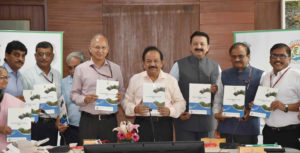- Union Minister for Environment, Forest and Climate Change, Dr. Harsh Vardhan on August 30, 2018 released ‘National REDD+ Strategy India’ in New Delhi.
- As per the Union Minister, the well-being of our forests is essential for a healthy living environment in the country. The Minister further emphasised that REDD+ activities will help in sustainable livelihood of local communities and also in conservation of biodiversity.
- The Minister stated that India’s National REDD+ strategy is one of the tools to achieve India’s commitment to Paris Agreement.
- REDD+ strategy will help the country to fulfill its NDC commitments and will also contribute to the livelihood of the forest dependent population.
- A National Governing Council of REDD+ chaired by the Union Environment Minister at the national level and two technical committees, headed by DG, Forest Survey of India and DG, ICFRE are being established for supporting the REDD+ implementation in the country.
- The REDD+ actions at the State level will be coordinated by the committee headed by the Principal Chief Conservator of Forests (PCCF) & Head of Forest Force (HOFF) of the States.
- In simple terms, REDD+ means “Reducing Emissions from Deforestation and forest Degradation”, conservation of forest carbon stocks, sustainable management of forests, and enhancement of forest carbon stocks in developing countries.
- REDD+ aims to achieve climate change mitigation by incentivizing forest conservation.
- The Indian strategy seeks to address drivers of deforestation and forest degradation and also developing a roadmap for enhancement of forest carbon stocks and achieving sustainable management of forests through REDD+ actions.
- The National REDD+ Strategy will soon be communicated to the UNFCCC.
- Paris agreement on climate change also recognizes role of forests in climate change mitigation and calls upon country Parties to take action to implement and support REDD+.
- India has communicated in its Nationally Determined Contribution under Paris Agreement, that it will capture 2.5 to 3 billion tonnes of Carbon dioxide through additional forest and tree cover by 2030.
- India’s first biennial update report to UNFCCC has revealed that forests in India capture about 12% of India’s total GHG emissions. Thus, forestry sector in India is making a positive cost effective contribution for climate change mitigation.
- Complying with the UNFCCC decisions on REDD+, India has prepared its National REDD+ Strategy.
- The Strategy builds upon existing national circumstances which have been updated in line with India’s National Action Plan on Climate Change, Green India Mission and India’s Nationally Determined Contribution (NDC) to UNFCCC.
About REDD+
- REDD+ stands for countries’ efforts to reduce emissions from deforestation and forest degradation, and foster conservation, sustainable management of forests, and enhancement of forest carbon stocks.
- The United Nations Collaborative Programme on Reducing Emissions from Deforestation and Forest Degradation in Developing Countries was launched in 2008 and builds on the convening role and technical expertise of the Food and Agriculture Organization of the United Nations (FAO), the United Nations Development Programme (UNDP) and the United Nations Environment Programme (UNEP).
- The UN-REDD Programme supports nationally led REDD+ processes and promotes the informed and meaningful involvement of all stakeholders, including indigenous peoples and other forest-dependent communities, in national and international REDD+ implementation.



